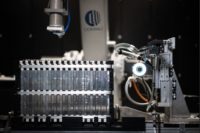Next-Generation EV Batteries May Be Made With Rocks

KONGENS LYNGBY, Denmark—Engineers at the Technical University of Denmark (DTU) here are developing solid-state batteries made from rock silicates. They claim that the devices will be environmentally friendly, more efficient and safer than traditional lithium-ion batteries. The new superionic material is based on potassium silicate, a mineral that can be extracted from ordinary rocks.
Rock silicates are some of the most common minerals in the Earth’s crust. They cover more than 90 percent of the Earth’s surface.
The material also works without the addition of expensive and environmentally harmful metals such as cobalt, which is currently used in lithium-ion batteries to boost capacity and service life. In addition, it is not sensitive to air and humidity, which makes it possible to mould the material into a paper-thin layer inside the battery.
“The potential of potassium silicate as a solid-state electrolyte has been known for a long time, but has been ignored due to challenges with the weight and size of the potassium ions,” says Mohamad Khoshkalam, a professor in DTU’s department of energy conversion and storage who is working on the R&D project. “The ions are large and therefore move slower.’
“We have shown that we can find a material for a solid-state electrolyte that is cheap, efficient, eco-friendly and scalable—and that even performs better than solid-state lithium-based electrolytes,” claims Khoshkalam.
According to Khoshkalam, the ions in rock silicates generally move slower than the ions in lithium-based liquid electrolytes or solid-state electrolytes, because they are larger and heavier. Khoshkalam and his colleagues have developed a patented process that makes the ions move faster than in lithium-based electrolytes.
“Before we see the solid-state battery on the market, however, there are several challenges that need to be solved,” warns Khoshkalam. “The technology works well in the laboratory, but is difficult and expensive to scale up.
“We [still] need to develop new ways of producing and sealing the batteries so the ultra-thin material layers in the battery cell do not break and have continuous contact in order to work,” explains Khoshkalam. “In the laboratory, you solve it by pressing the layers of the battery cell together at high pressure, but it is difficult to transfer to a commercial electric car battery, which consists of many battery cells.”
Unlike lithium solid-state batteries, solid-state batteries based on potassium and sodium silicates also have a low technology readiness level. “This means there is still a long way to go from discovery in the lab to getting the technology out into society and making a difference,” says Khoshkalam. “The earliest we can expect to see them in new electric cars on the market is 10 years from now.”
Khoshkalam is in the process of establishing a start-up company called K-Ion, which will develop solid-state electrolyte components for battery companies. The next step is to develop a demo battery. A prototype is expected to be ready within the next two years.
Looking for a reprint of this article?
From high-res PDFs to custom plaques, order your copy today!






